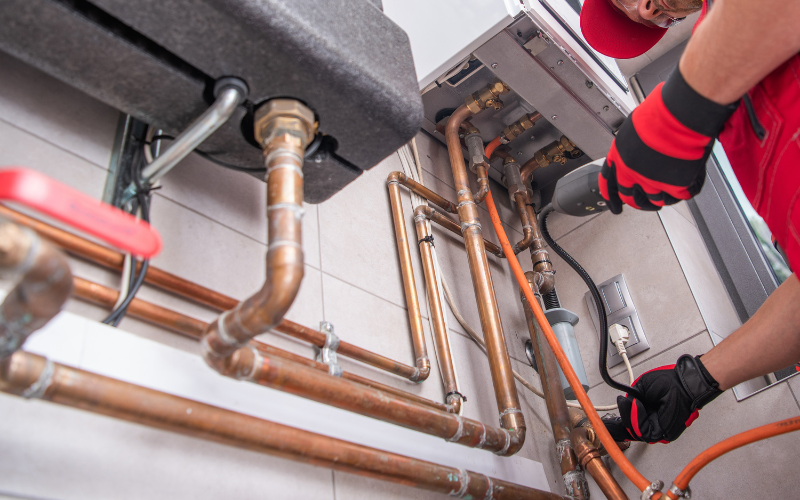How Fixed Gas Detection Systems Work
Fixed gas detection systems are essential for maintaining safety in commercial, industrial, and research settings. These systems contribute to accident avoidance, life safety, and regulatory compliance through constant monitoring of dangerous gas levels.
Discover the science underlying fixed gas detectors, their parts, and their effective operation.
How Fixed Gas Detectors Work
A fixed gas detector is a stationary device designed to continuously monitor the environment for the presence of specific gases. These systems use advanced sensing technologies to identify dangerous concentrations of gases such as carbon monoxide, methane, hydrogen sulfide, and more. The process involves detecting, analysing, and signalling potential hazards in real-time.
Key technologies used in fixed gas detection systems include:
- Electrochemical Sensors: These sensors detect gases by measuring changes in electrical currents caused by chemical reactions between the gas and a sensing electrode. They are ideal for detecting toxic gases such as carbon monoxide and hydrogen sulfide.
- Catalytic Bead Sensors: Commonly used for combustible gas detection, these sensors measure the heat generated from oxidation reactions when flammable gases come into contact with a heated element.
- Infrared Sensors: Infrared (IR) sensors detect gases by analysing how specific gas molecules absorb infrared light at certain wavelengths. They are widely used for monitoring hydrocarbon gases and carbon dioxide.
- Photoionisation Detectors (PIDs): PIDs use ultraviolet light to ionise gas molecules, measuring the resulting ionised particles to detect volatile organic compounds (VOCs).
Each of these technologies enables fixed gas detection systems to address diverse industrial requirements.
Components of a Fixed Gas Detection System
The effectiveness of a fixed gas detection system depends on its components, which work in tandem to monitor, detect, and respond to hazardous gases.
Key components include:
- Sensors: The primary elements responsible for detecting gases. Each sensor type is tailored to specific gas types and detection ranges.
- Control Units: These devices process sensor data and trigger alarms or other safety mechanisms when gas levels exceed preset thresholds.
- Alarms and Indicators: Visual and audible alarms alert personnel to the presence of hazardous gases. Some systems also include strobe lights for noisy environments.
- Communication Systems: Advanced fixed gas detection systems integrate with facility-wide safety systems and remote monitoring tools, allowing for real-time alerts and centralised management.
- Power Supplies: Reliable power sources ensure uninterrupted operation. Many systems include backup batteries or uninterruptible power supplies (UPS).
How Gas Detection Services Ensure System Efficiency
Fixed gas detection systems require regular maintenance and calibration to ensure accurate performance. Gas detection services provided by professional teams are essential for system reliability.
These services include:
- Routine Calibration: Sensors can drift over time, leading to inaccurate readings. Regular calibration ensures sensors respond accurately to target gases.
- Functional Testing: Testing ensures that alarms, indicators, and communication systems operate as intended during emergencies.
- Sensor Replacement: Over time, sensors may degrade due to environmental factors. Timely replacement prevents gaps in detection capabilities.
- System Upgrades: Gas detection service providers can recommend and implement technology upgrades to enhance system performance and compliance with evolving standards.
Applications of Fixed Gas Detection Systems
Fixed gas detection systems are indispensable in various industries due to their ability to provide continuous, real-time monitoring.
Common applications include:
- Oil and Gas: Detecting combustible gases like methane to prevent explosions.
- Chemical Manufacturing: Monitoring toxic gases such as hydrogen sulfide and ammonia.
- Mining: Ensuring safe levels of oxygen and detecting harmful gases like methane.
- Wastewater Treatment: Detecting hydrogen sulfide and other hazardous gases.
- Food and Beverage: Monitoring carbon dioxide levels in production areas.
Benefits of Fixed Gas Detection Systems
Fixed gas detection systems provide several critical advantages:
- Continuous Monitoring: Unlike portable detectors, fixed systems offer 24/7 gas monitoring.
- Early Warning: Prompt detection and signalling allow timely evacuation and mitigation.
- Integration with Safety Systems: Many systems integrate with facility-wide alarms and ventilation controls.
- Regulatory Compliance: These systems help industries meet safety and environmental standards.
- Cost-Effectiveness: Fixed gas detection systems reduce downtime and liability costs by preventing accidents.
Conclusion
Fixed gas detection systems are critical for preserving operating effectiveness and safety in hazardous workplaces. By leveraging advanced sensor technologies and reliable gas detection services, these systems provide accurate, continuous monitoring to detect and mitigate risks. Purchasing a reliable fixed gas detector and making sure it receives routine maintenance demonstrates a dedication to operational excellence and worker safety.
Visit ANSAC to enhance your workplace safety today!





